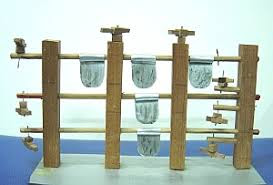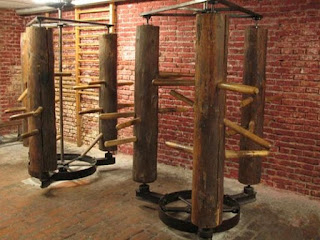Training devices that imitate the height, weight and resistance
of an opponent are a logical development for combat training in virtually all
cultures. Different types of this kind of training equipment was use all over the world since the ancient times. While many cultures simply lost and forgot their martial arts and training equipment that goes with them with arrival of modern firearms and modern ways of fighting China for the most part preserved many of its old martial styles and exotic training devices. Wooden dummies are especially popular among Southern kung fu styles. Over time a wide variety of wooden dummies were developed to suit the needs of each particular style. This article will be just a presentation of the variety of this training devices without deep explaination of their purpose and use.
CHOY LEE FUT
Choy Lee Fut is, without any doubt, the kung fu system
with the widest range of wooden dummies, both to train empty hand and weapons
techniques. Generally speaking, all
these dummies share a number of common objectives to develop the students'
skills, such as distance control and impact precision. In addition, each of
these dummies helps the students to sharpen the striking pressure areas and
they improve different types of skills, from the most basic ones to the more
advanced abilities, the internal and external fighting systems and their
combination:
CHEUNG BAU JONG “Wall bag” strengthens all parts of the
hand you use to hit: fist, palm and fingers. It also teaches how to use the arm
that is not hitting to generate and transmit impact strength into the hand or
fist which is hitting.
CHING JONG
“Balanced dummy”. This dummy, apart from strengthening hands and fists, it also
strengthens the forearms (Kius) and teaches to intercept or block with the arm
and to place it in a suitable position so as to provide a good protection.
Sometimes, the arm can hit and block simultaneously.
 |
| CLF ballanced dummy |
 |
| CLF sand bag dummy |
SAM SING SAH
BAU JONG “three sand bags dummy”. It shares the same goals and principles as
the Sah Bau Jong but adding the difficulty of having three sand bags instead of
one. This is like fighting with three opponents at the same time.
 |
| CLF soi sau jong |
MA JONG Unique to this dummy is the heavy spring-loaded
horizontal log shaped in the form of a horse. The log is mounted on wheels and
springs in such a way that when pushed back the horse charges forward, forcing
the practitioner to defend and control the dummy.
Power and a flexible horse stance are used to avoid and
redirect the energy generated by the heavy log. The use of two interlocking
spinning arms also requires a quick eye, together with fast and accurate hands
to hit the targets between the rotations of the arms. The dummy is designed to train a combination of speed,
accuracy and power. PALM BLOSSOM and SMALL PALM BLOSSOM WOODEN DUMMIES
 |
| Palm blossom wooden dummy |
 |
| small palm blossom wooden dummy |
RICE BAG wooden dummy , rarely seen training equipment of Choi Lee Fut
 |
| Rice Bag dummy |
TRI STAR dummy, there are two variants of this training tool , one is used for empty hand techniques while other for knife fighting training
 |
| Knife tri star dummy |
 |
| Empty hand tri star dummy |
SPRING DUMMY is a wooden trunk with a spring that connect the base of the dummy with the floor. Purpse of this dummy is to provide reacting force to the punches and kicks.
 |
| Spring Dummy |
 |
| Another example of CLF dummy |
WING CHUN
Wing Chun wooden dummy is probaly the best known variant of these kind of training equipment due to planetary popularity of the style its self. Woooden dummy has very interesting history in Wing Chun style, interesting
in a sense that no one knows who and when introduced this training tool to the
style. Common believe is that wooden dummy came from the red boats that they
were either mechanical part of the boat or they were training tools form opera
students, but some independent historical research about red boats and history
of the opera house didn’t mention wooden dummy anywhere, in any context.We don’t
know whether or not Leung Jan used wooden dummy and if he did , how did he used
it, Was he the one who first used Wooden Dummy in his training ? Or maybe some
of his students? Same goes for Chan Wah Shun and later generations . First
complete wooden dummy set , in a way we know wooden dummy sets today was
created by Yuen Kai San .
First version of wooden dummies were of a type now called Dai Jong ,Ground Dummies, also sometimes referred to as “buried” or “dead” dummies. One third of the dummy would be burried in the ground.
 |
| Dai Jong |
Yip Man , due to the lack of space in Hong Kong invented (or some say stoe the idea from Dai Dak Lan training hall) a wall mounted dummy.
 |
| Yip Man training on wall mounted dummy |
Bamboo dummy is used sporadically in a few Wing Chun styles. It is very different
from Wooden Dummy, it has elastic hands and some even call it “chi sao” dummy ,
also it has several different “hand positions”
which enables training of variety
of situations and techniques . Main purpose of this training device is to
develop trapping skills and enhance chi sao reflexes and control of the
opponent’s arms
 |
| bamboo dummy |
Tripodal dummy or Gerk Jong is a training tool introduced to Wing Chun by Leung Ting. It is unknown where did he get the idea for this training device. Gerk Jong is made of three wooden pillars half burried into the the ground in trianglular shape one meter apart. It is used to training kicks and leg blocks.
 |
| Gerk Jong |
Some styles of Wing Chun developed over time their specific and pretty unique Wooden Dummies
 |
| Vinetnamese Wing Chun dummy |
 |
| Cho Gar dummy |
WENG CHUN
WENG CHUN POLE DUMMY. Weng Chun style , which is a mixture of Wing Chun and Hung Kuen share wooden dummy and other equipment with Wing Chun. One unique training device found in Weng Chun is Long Pole dummy used as the name says for practicing Long Pole techniques
 |
| Long Pole dummy |
WHITE EYEBROW
Some White Eyebrow school use wooden dummy pretty similar to Wing Chun dummy except it has two legs. CHOW GAR
 |
| Bai Mei wooden dummy |
CHOW GAR
Chow Gar or Southern praying mantis style has a wooden dummy developed for the style's specific requirements
 |
| Chow gar wooden dummy. |
 |
| Another type of chow gar dummy |
GOLDEN DRAGON
R. W. Smith,one of the first westerners who studied various forms of Chinese boxing
in Taiwan in the 1960s, noted the use
of dummies in various styles and provided informatios about that in his books.
" SHAOLIN" STYLE FROM FUJIAN
In his book "Chinese Boxing: Masters and Methods " Robert W.Smith describer an event when he was introduced to
Wu Ku-Ts’ai in Tainan. Wu studied in Yong Chun County. Smith states that his style was simply
“Shaolin.”
Wu was a believer
in the importance of physical conditioning.
His students who were all family members practiced strikes on the post
pictured here. It does not appear that Wu had a dedicated
dummy form, at least not that he shared with Smith.
WHITE CRANE
Vast majority of White Crane styles do not use any kind of wooden dummy. Few styles use exactly the same wooden dummy as in Wing Chun. It remains unclear which art first developed this particular kind of wooden dummy. Some styles use wooden dummy that is basically same shape as wing chun dummy , the only difference is the distance between arms which is a bit larger in White Crane.
 |
| White Crane dummy |
 |
| White Crane dummy |
 |
| White Crane dummy |
MOK GAR
Mok
Gar is one of the famous 5 family styles from Guangdong. This style uses very
simple form of wooden dummy. It is actually a wooden pillar without any
attachments. It is used for training kicks and conditioning the arms
BLACK TIGER
Shaolin Black Tiger is a rare form of southern Chinese
Kung Fu that traces its roots to Southern Shaolin monastery. Style uses an
interesting form of wooden dummy which “head” can be adjusted according to the height
of the practitioner. This dummy is made of stone and has metal arms and legs
Black Tiger Sifu Wong Cheung was movie advisor for Hong Kong action movies and influenced fight coreographies for many years, he also appeard in one of "Shaw Brothers" classics.
BA GUA
Ba Gua is one of the most famous "soft" styles practiced today. In Ba Gua style there are several different dummies. The simplest one is just a wooden pillar half burried i to the ground . Next variation is a simple variant with two hands to practice kicks and punches. There is a variant of the same dummy with four hands and last variant is a four hands dummy that can move arround central axis.
CHOI MOK PAI
The five most common styles of southern Shaolin are Hung, Lau, Choi, Lee and Mok, named after the five great masters that taught in the south. Choi Mok Pai, takes its name from two from them, but it has also been influenced and contains elements from all these styles as well as a few others, that the founder of the system had learned.There are two different kinds of wooden dummy in this system, they are just slightly different. First wooden dummy of this system is pretty much the same shape and size as Wing Chun dummy but has only two upper hands .
The five most common styles of southern Shaolin are Hung, Lau, Choi, Lee and Mok, named after the five great masters that taught in the south. Choi Mok Pai, takes its name from two from them, but it has also been influenced and contains elements from all these styles as well as a few others, that the founder of the system had learned.There are two different kinds of wooden dummy in this system, they are just slightly different. First wooden dummy of this system is pretty much the same shape and size as Wing Chun dummy but has only two upper hands .
 |
| Choi Mok Pai Wooden Dummy techniques |
Second wooden dummy of the style is almost identical to first version with only one difference , it has three arms, all mounted as close as possible .
 |
| Three arms dummy of choy mok pai |
HUNG GAR
Hung gar is style with probaly the largest numbers od wooden dummies after Choy Lee Fut. Some wooden dummies are adopted from other systems like Choy Lee Fut and Wing Chun while others are originaly built for Hung Gar. Wooden dummies in this system have great variations in size and complexity. Dummies range from simple bamboo pole to elaborate mechnacial contraption with a lot of moving parts.
 |
| plum blossom dummy |













